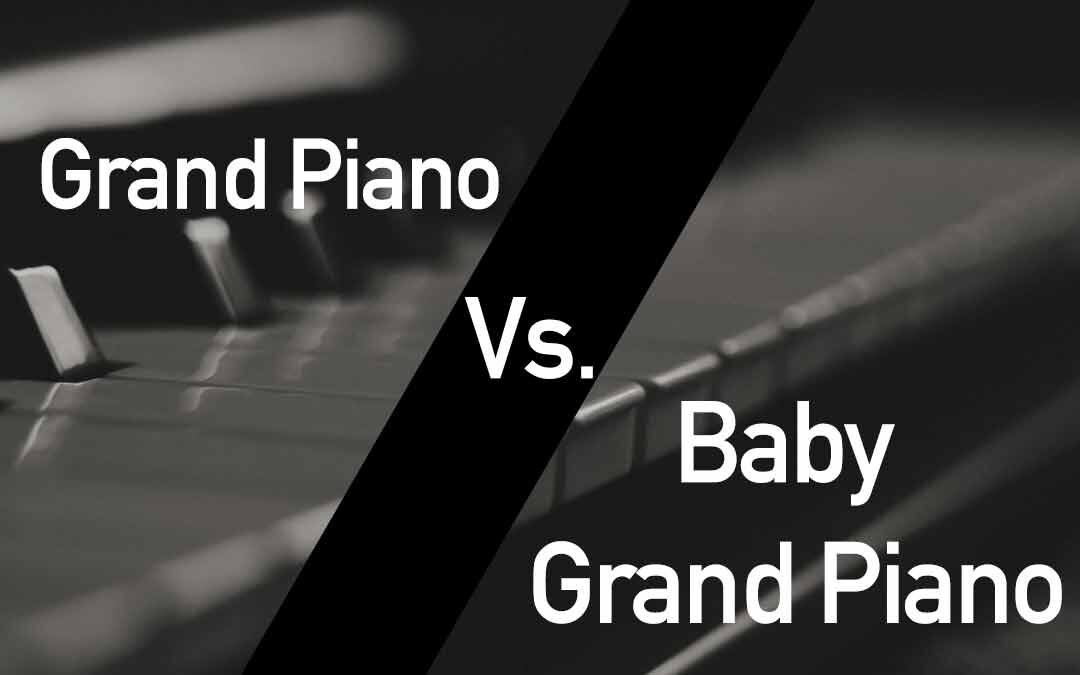Whether you've been playing the piano for years or simply enjoy the sound of it from time to time, it's no secret that grand pianos and baby grand pianos make amazing musical instruments. This blog post discusses Grand Piano vs. Baby Grand Piano. Grand pianos and baby grand pianos share several features, such as strings and hammers, but there are also important differences between them.
we will discuss their similarities and differences - and how they might suit your individual music needs. So get comfortable; let’s dive into these two amazing pieces of musical equipment!
This information will help you decide what type of piano best suits your needs, whether you're a seasoned musician or a beginner.
Let's get started!
The Origins of the Piano
The piano is a beloved and iconic instrument that has been a fixture of Western music for centuries. But where did this fantastic instrument come from, and how did it evolve into the form we know today?

The piano has a long history, beginning with its invention in the 1700s by Bartolomeo Cristofori, who lived in Padua, Italy (1655-1731). He sought to create an instrument with a greater range of expression and volume.
This led to the creation of the first true piano, called a pianoforte (meaning "soft-loud" in Italian), because of its ability to produce a wide range of dynamic expressions. This instrument used hammers instead of plucking strings, so players could play quickly or sustain notes.
Players could play the piano louder or softer depending on how hard they pressed the keys.
Additionally, players could sustain notes by holding down a key on the instrument or create sharp staccatos by striking the keys rapidly.
In the late 18th century, the pianoforte became popular over the harpsichord due to its greater expressiveness and variable volume.
With time, as the piano's popularity grew, it became a staple in the homes of distinguished families. Its versatility has made it a favorite among professionals and amateurs alike.
The term "grand" meant large and was first used to describe any piano (upright or horizontal) with long strings. Later, the word "grand" became synonymous with horizontal pianos, usually larger than their upright counterparts.
Due to their smaller footprint, upright pianos remained the most popular type of piano for domestic use for years after their invention. However, piano manufacturers continued to make smaller pianos suitable for home use.
The name "baby grand" is often attributed to the piano maker Hugo Sohmer, though it is unclear when the first baby grand piano hit the market. In 1884, Sohmer & Company created the first 5" grand piano, marketed as a baby grand.
Since then, baby grand pianos have continued to be popular in living rooms and smaller spaces worldwide. The baby grand was an instant success and soon became a staple of the piano industry.
The Different Types of Grand Pianos
Pianos have two major types: vertical pianos and horizontal pianos.
Vertical pianos (a.k.a. upright pianos) are constructed vertically and sit against a wall. They get this name because of the vertical placement of its strings and soundboard.
The strings run vertically, perpendicular to the keyboard. The hammers of an upright piano move horizontally and use springs to return to their resting position.
Upright pianos are smaller and more compact than grand pianos, making them popular for home use and other small spaces such as schools, churches, etc. They are also less expensive and produce a rich, full sound, although it may not be as nuanced as a grand piano.
Horizontal pianos (a.k.a. grand pianos) sit on three legs horizontally. They get this name from their length and the horizontal placement of the strings and soundboard. This allows longer strings and a greater area of the soundboard.
Grand pianos are the best, largest, and most expensive type of piano. Although grand pianos are typically more expensive than upright pianos, they also offer excellent responsiveness and super tonal quality.
Both "grand" and "baby grand" pianos fall under the horizontal piano category. Grand pianos are famous in professional studios, concert halls, and other classical music venues.
As I stated before, grand pianos come in various shapes and sizes. Here are different types of grand pianos:
Petite Grand Piano
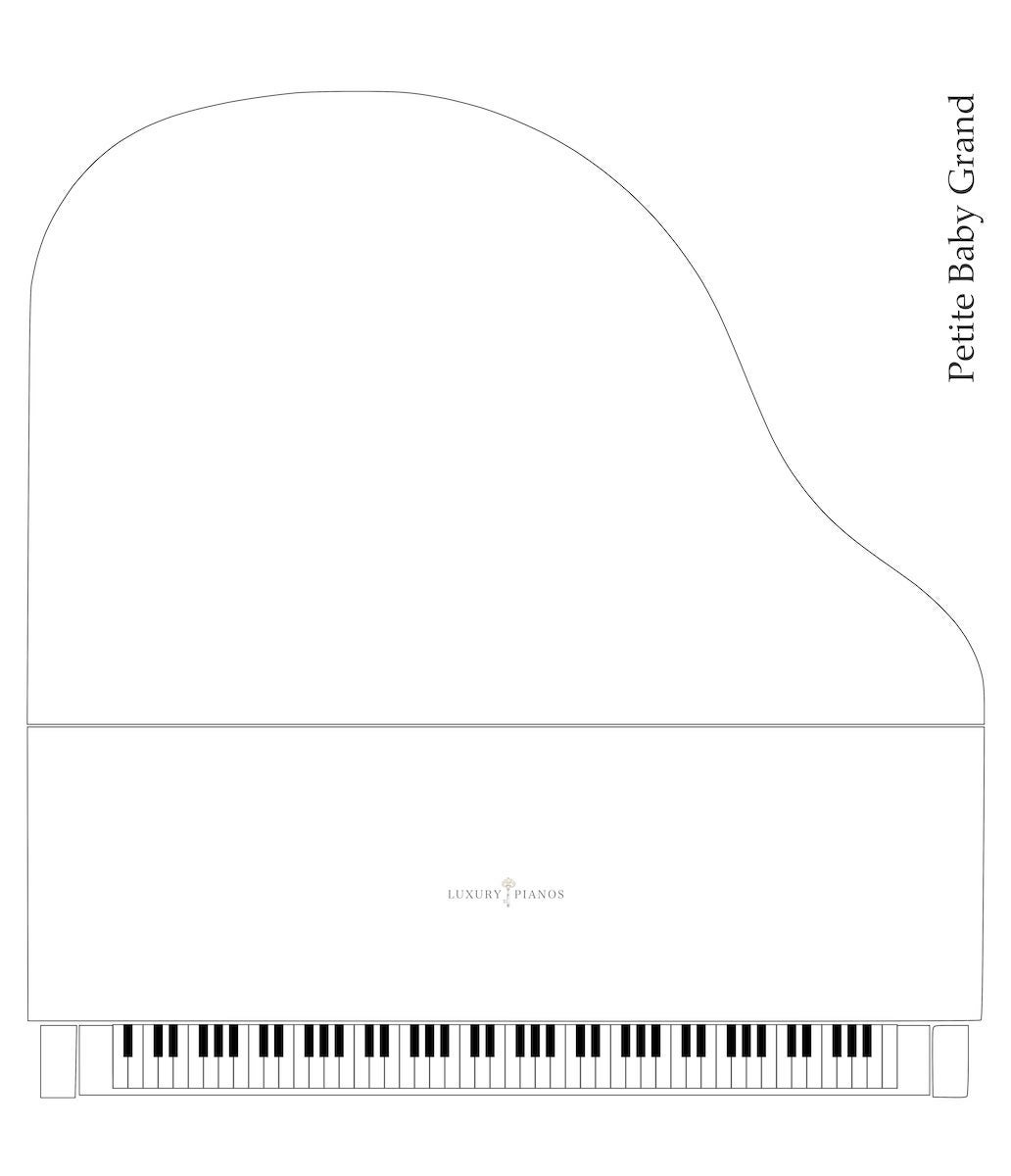
Petite baby grand pianos are the smallest pianos in the grand piano line. They are typically 4'5" to 4'11" feet long and are the most affordable grand pianos. They offer a less resonant, warmer, and quieter sound than other grand piano models.
Baby Grand Piano
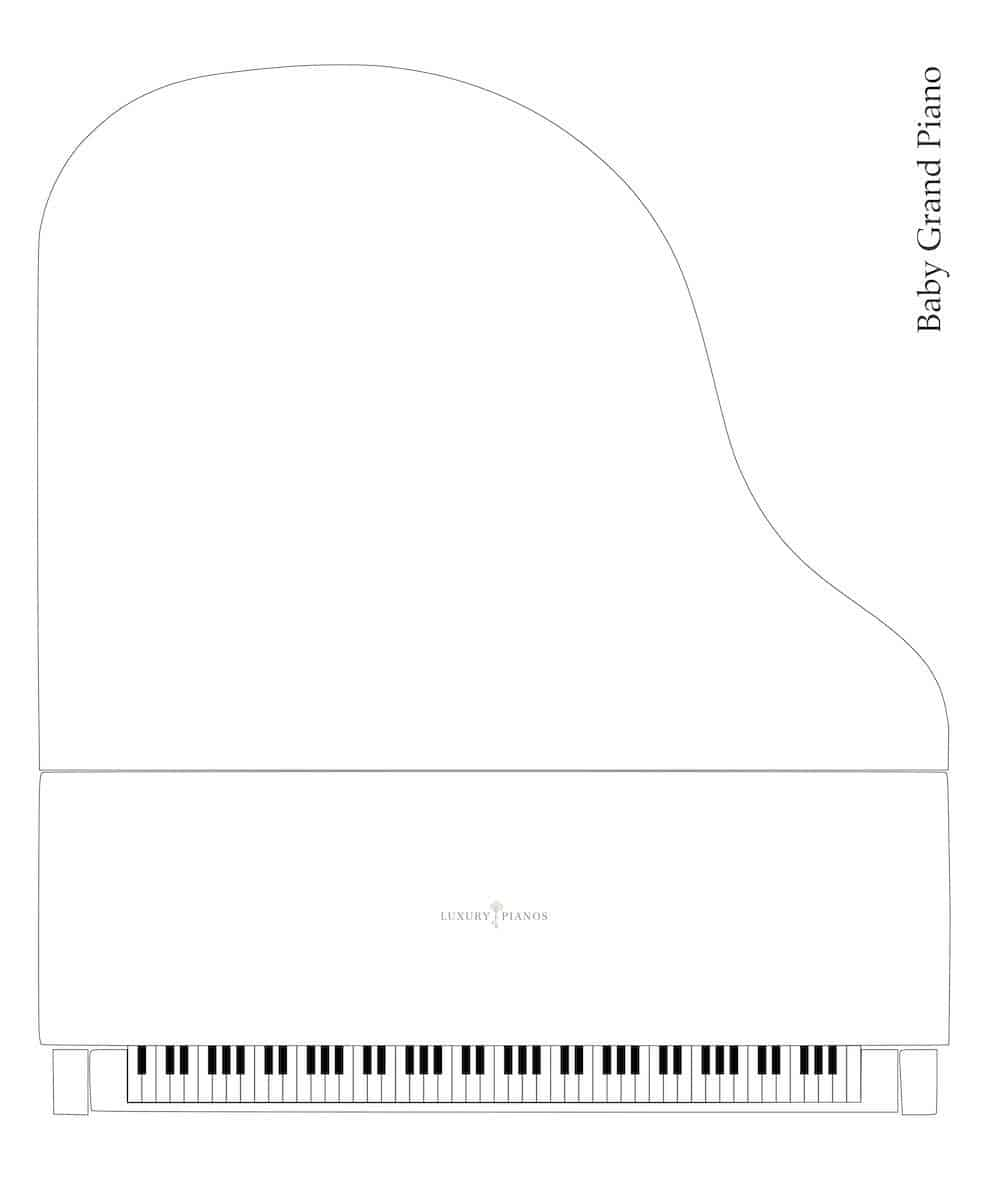
Baby grand pianos are one of the most popular and smallest models in the grand piano family. Baby grands usually measure between 5' and 5'6", making them popular for domestic use. They deliver excellent sound quality at a more affordable price than larger models.
Medium Grand Piano
Medium grand piano, also known as a classic grand, ranges from 5′ 7″ to about 5′ 9″. It is slightly larger than the baby grand. It has a deeper soundboard and can produce a more powerful sound than the smaller models.
Living Room Grand Piano
Living room grand pianos measure between 5'9" to 5'11". They are sometimes referred to as classic grand pianos. Their larger soundboards, more strings, and more powerful sound make them more powerful than smaller models.
Professional Grand Piano
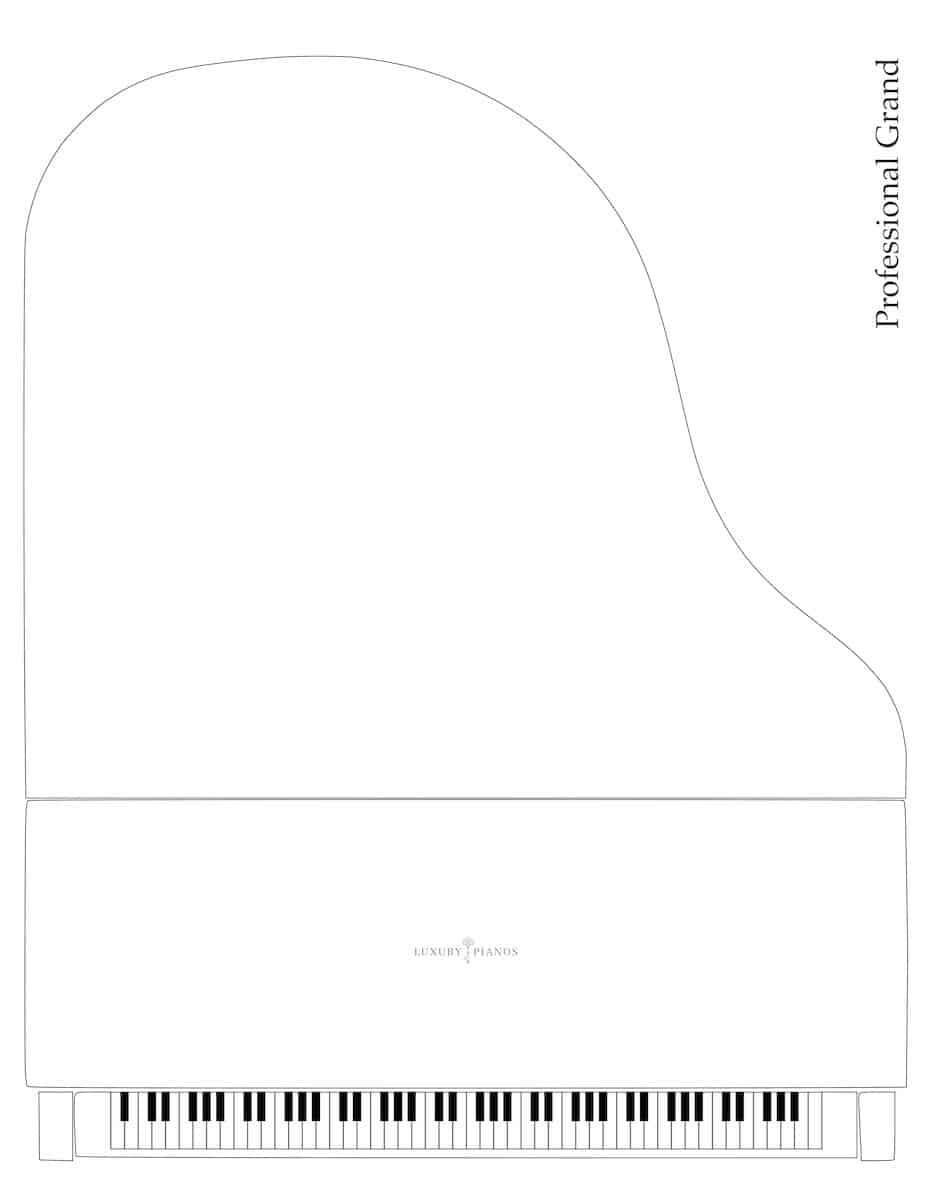
Professional grand pianos, also known as full-size grand pianos, are 5′ 9 to 6′ 2 feet long. They are the middle-sized grand pianos to which people usually refer when discussing grand pianos.
They offer more powerful and excellent sound quality. The sound is natural and warm, and they have great resonance.
Parlor Grand Piano

Parlor grand pianos, also known as music room grand pianos, are popular for home concerts because of their great sound, resonance, and dynamics. These piano models are about 6'3″ and 6′ 10″ long.
You can usually find this medium to large grand piano in schools and universities.
Additionally, they are a magnificent living room centerpiece with a rich professional sound.
Semi-Concert Grand
Semi-concert grand pianos (a.k.a. ballroom grand pianos)are the second-largest and most expensive models in the grand family. They are around 6'11" to 8'6" feet long.
Semi-concert grands are loud and have great sonic qualities, with warm, clear, natural, and dynamic sounds. They are ideal for public performances in concert venues, recording studios, and ballrooms.
Concert Grand
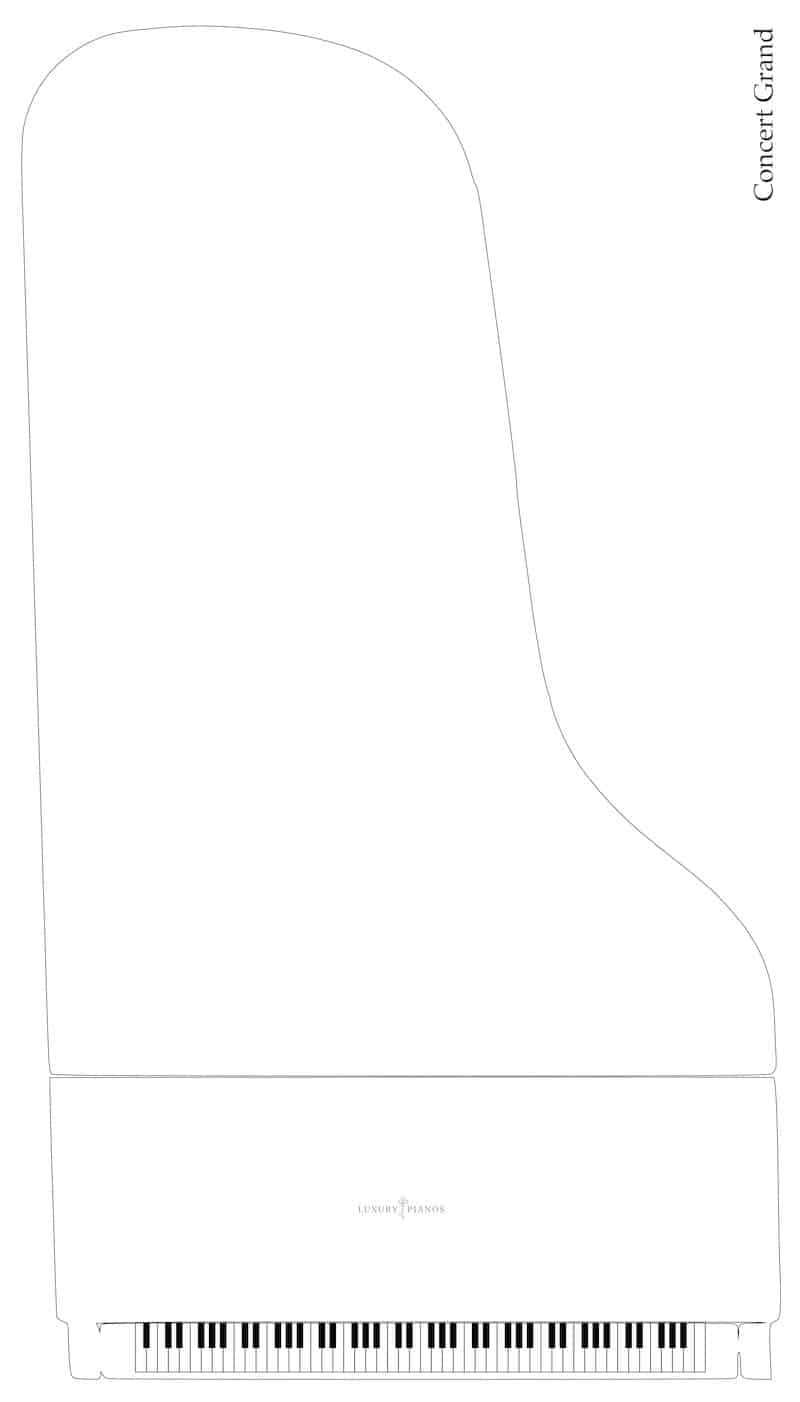
Concert grand pianos are the largest and most powerful grand pianos. Typically, they are between 8'11" and 9' in length.
The concert grand piano produces the highest volume, richest sound, and most balanced tone. Their magical sound quality and power make them the choice of professional pianists for performances in larger music venues. They are also the most expensive type of grand piano.
The size of the grand piano affects the sound quality and volume, with larger pianos generally producing a fuller, richer sound.
What's the Difference?
Now that we have discussed the different types of grand pianos, it's time to compare the baby grand piano and grand pianos based on their key features!
Differences in Size
The main difference between a grand piano and a baby grand piano is their size. Baby grand pianos are the shortest type, while concert grand pianos are the longest.
A baby grand piano measures between 4'5" and 5'8" in length.
In contrast, a grand piano, also called a concert grand, typically measures 8'11" and exceeds 9 feet long.
Since 88 keys became a standard in the 1880s, almost all pianos have 88 keys. Therefore, the width measurements of grand pianos do not vary much.
The length of a piano, from the keyboard to the tail end of its lid, determines its size.
Although I have already covered grand piano types above, here is a quick rundown of their average lengths:
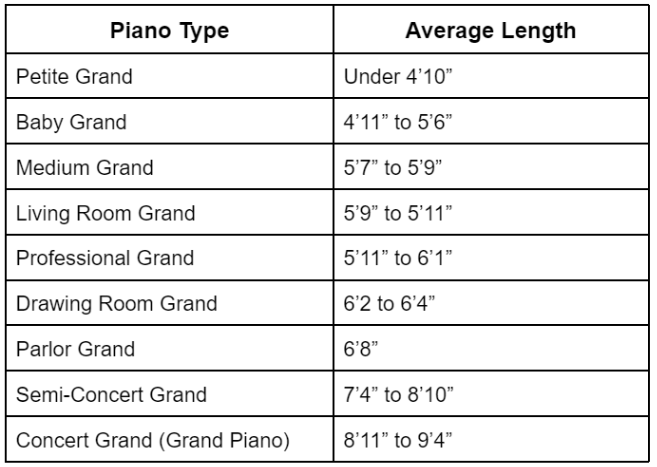
The above table shows that full-sized grand pianos and baby grand pianos differ significantly in length. A full-sized grand piano is about twice as long as a baby grand piano.
As a result of this physical difference, there are noticeable tonal and dynamic differences, which we'll discuss shortly.
Baby grand pianos are more compact and can better fit smaller spaces. The smaller models, such as the baby grand piano, are perfect for homes, recording studios, and rehearsal spaces. Despite their size, they still provide a beautiful sound.
On the other hand, grand pianos take up more space and are difficult to fit into smaller rooms or homes. A grand piano is only used in a home if the area is large.
Typically, these pianos are found in concert halls, where large volumes can be fully utilized and have sufficient space for their length.
Differences in Sound
In addition to their length differences, baby grand pianos and grand pianos also differ in their sound quality. However, a high-quality baby grand piano can produce a similar sound to a full-size grand piano.
Longer strings and a larger soundboard in a grand piano give it a fuller, richer sound and more resonance.
As a result, longer grand pianos have better sonic performance than baby grand pianos. Baby grand pianos produce less volume than grand pianos due to their shorter length.
The lower tones will be deeper and more resonant, while the higher tones will be brighter and more vibrant. That means full-sized grand pianos have softer overtones, while baby grand pianos sound sharper with their harmonics.
As a general rule, the longer the piano, the more balanced the overtones.
Grand pianos have the volume to fill large spaces, so their sound will likely travel farther. For a smaller space, a baby grand piano is best.
As the largest piano variety, concert grand pianos have longer strings than smaller grand pianos, allowing them to produce both quieter and louder sounds.
It's also important to remember that a space's acoustics will impact the loudness and tone of a grand piano. A concert grand piano may sound muddy if you use it in a small room because the resonance may be too overwhelming.
In contrast, a baby grand piano will sound more precise and defined in a smaller space because the maximum volume will fill the room rather than causing an overwhelming resonance.
Grand pianos produce a louder and more intense sound for larger spaces than baby grand pianos. They create richer sounds with better overtones.
Differences in Key Action
The key action is another factor in which baby grand pianos and grand pianos may differ. It affects their playability. The string length plays a direct role in this.
Usually, larger grand pianos have longer hammers and keys. The longer hammers that strike longer keys produce more kinetic energy with the longer mechanism. It gives the pianist more control over the dynamics, sound quality, and color of the music they play.
That's why concert grand pianos are the most popular options for professional players to demonstrate their total control and skill.
On the other hand, baby grand pianos have shorter strings, hammers, and keys, leading to less control over the dynamics of the notes.
However, a high-quality baby grand piano expertly crafted with the finest materials and components can play better than an entry-level concert grand piano.
Overall, grand pianos have better key action than baby grand pianos. But it can feel vary with different pianos from different brands.
Grand pianos tend to have a more responsive action, allowing for more control and expression in your playing. Even though baby grand pianos may not have quite as refined of action, they can still provide a satisfying playing experience.
Differences in Price
The price of grand pianos varies depending on the type, the brand, and the instrument's condition.
Usually, grand pianos tend to be more expensive than baby grand pianos due to their larger size and more complex construction. However, different manufacturers can have different prices.
Baby grand pianos are the most miniature and most affordable grand pianos. They typically cost between $8,000 to $50,000.
The prices of professional grand pianos or parlor grand pianos usually range from $10,000 to $50,000, while music room grand pianos typically cost between $60,000 to $250,000.
Parlor grand pianos or professional grand pianos cost around $10,000 to $50,000, while music room grand pianos cost $60,000 to $250,000.
In contrast, semi-concert and concert grand pianos are the most expensive pianos. The price of these pianos typically starts from $130,000 and goes up to $200,000, depending on the brand and finish.
Overall, baby grand pianos are significantly more affordable than grand pianos.
Which One Is Right For You?
Now that you know all the differences between baby grand and grand pianos, it's time to decide which is best for you.
The best grand piano for you will depend on your playing skills, room size, and the purpose of the piano.
A grand piano is the best option if you have ample space and money is not an issue. Grand pianos do best in rooms with high ceilings and abundant open space. They will create sounds that resonate freely without becoming muddy.
Grand pianos are better suited to professionals who perform in front of audiences and must practice on a full-sized instrument. They offer a fuller, richer sound and excellent playability. Therefore, a grand piano is a good investment if you're a professional musician.
But many people forget to consider how they will fit the piano into the available space when buying it. Since grand pianos are extremely heavy, you need to hire professionals to transport them.
Although baby grand pianos are lighter than grand pianos, they are still very heavy. When getting a piano into your home or other building, you should also take measurements of doorways, staircases, or any other obstacles.
Beginners who want to learn the piano basics may not need a full-sized grand piano. A baby grand piano is an ideal choice if you're a beginner with limited space and budget.
Whether a newbie or an experienced piano player, a baby grand piano is the best choice if you have a limited budget and space.
In short, a baby grand piano is perfect for you if you're a beginner who wants an affordable and small grand piano. However, a grand piano is ideal if you're a professional pianist who wants the highest quality sound, excellent playability, and no budget or size limitations.
How To Choose A Grand Piano (Buying Guide)
The following are some crucial factors to consider when buying a grand piano:
Room Size
The room size is one of the most important things when choosing a grand piano.
A baby grand piano will be a good choice if you have a small space. Compared to a baby grand piano, which can fit in a smaller space like a living room or classroom, a grand piano is bigger and will take up more space.
If you want to purchase a grand piano, ensure ample space since grand pianos are the largest instruments. A spacious room with high ceilings is the best place to play a grand piano. With ample space, the piano can achieve proper resonance and be played dynamically.
So, measure the space you have available before purchasing a grand piano. You will also need to add a few extra feet to the length to accommodate the piano bench.
Purpose of the Piano
Another essential factor when choosing a grand piano is the purpose of the piano. If you are looking for a grand piano for a theater, recital hall, or other performance space, a concert grand is often the best choice. It produces a professional and clean sound that can easily fill a large concert hall.
A beautiful baby grand piano could be the ideal choice if you're a beginner looking for an aesthetic addition to your living space. You can also use Baby Grand pianos in small rooms in your home or workplace.
A mid-sized grand piano, such as a professional or parlor grand, would be ideal for a school theater, large music classroom, or music club. The standard grand piano offers a rich sound without taking up as much space as the full-sized concert grand piano.
If you are buying a piano for teaching purposes and price is a concern, you may consider getting a slightly smaller grand piano or purchasing a used piano.
Player Skill Level
It's also important to consider your piano skill level when choosing a piano. If you're a beginner pianist looking to learn how to play the piano and hone your skills, a smaller baby grand piano is a good choice.
Professional pianists often prefer concert grand pianos because of their improved tonal quality and resonance. The harmonics of larger grand pianos allow professional musicians to showcase their skills.
Whether you are a beginner pianist or enjoy playing piano for fun, a high-quality baby grand piano will still provide a fantastic sound.
Budget
Price is one of the most crucial factors when purchasing a product. The cost of a grand piano varies significantly according to its model, manufacturer, production year, and condition.
Usually, baby grand pianos are more affordable than larger grand pianos.
Don't make the mistake of buying the largest grand piano you can afford just because it's the largest you can afford. Instead, look for a high-quality piano within your budget.
You can get better results from a quality baby grand piano than an inexpensive larger one.
Brand
Various brands of grand pianos are available. Choose a reliable and reputable brand known for producing the best grand pianos.
Some popular grand piano brands include Steinway & Sons, Yamaha, Kawai, and Baldwin. These brands are known for producing superior-quality pianos with excellent sound qualities, outstanding playability, and other features.
Each brand has its unique sound and characteristics. Research the different brands and find one that suits your needs and budget.
By considering these factors, you should be able to find the perfect grand piano for your needs and budget.
Conclusion
As you can see, I've compared the grand piano and baby grand piano in detail. Both types of pianos offer a variety of advantages and disadvantages and are ideal for different players.
Ultimately, choosing which type of piano is right for you depends on the purpose of the piano, the space available, your piano skill, and your budget.
If you're looking for a larger grand piano that provides a full sound and a wide range of tones, then a grand piano is the best choice.
But a baby grand piano would be a great option if you want something smaller and more affordable. This piano offers a beautiful and enjoyable playing experience despite its smaller size.
Whether you choose a grand piano or a baby grand piano, you'll love these fantastic instruments' beautiful sound and craftsmanship.
Hopefully, this article has helped you decide which one to choose.
Related Topics
- Learn How To Play Keyboard Synthesizer
- How Many Keys Are Most Electric Keyboards?
- Left hand Exercises Piano
Harlan Kilstein began playing piano during covid with no piano background at all. He taught himself how to play learning what to do and what not to do.
Today he's an advanced intermediate player and can help you grow in your skills because he learned all this on his own.

